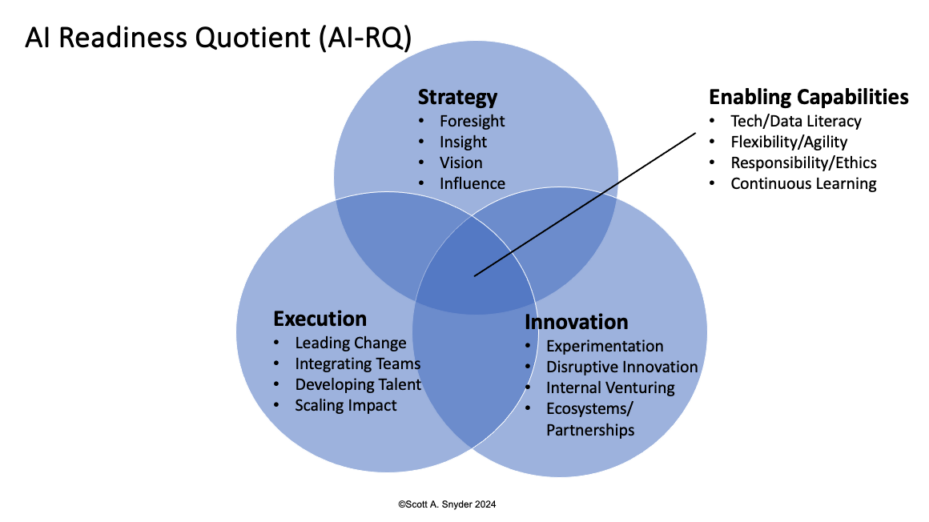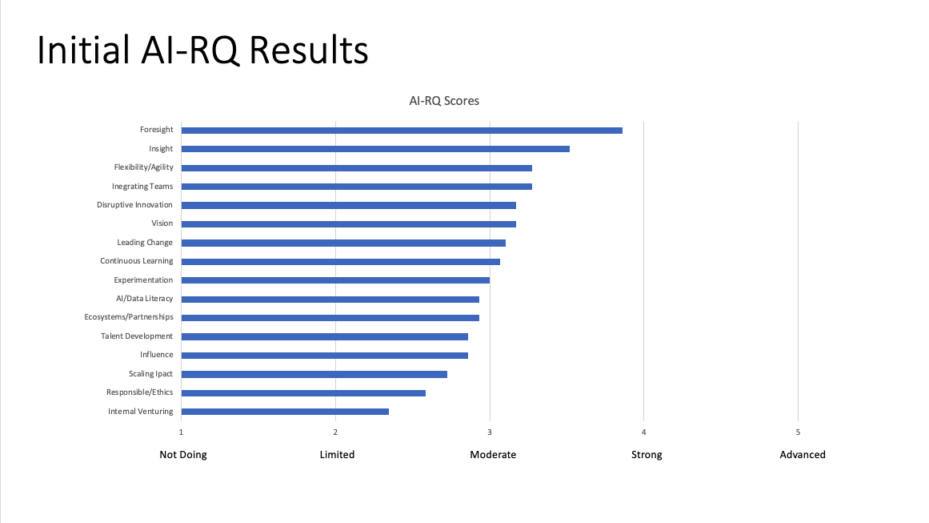The following article was written by Scott A. Snyder, a senior fellow at Wharton, adjunct professor at Penn Engineering, and chief digital officer at EVERSANA.
Back in 2019, most leaders were still grappling with advancing digital transformation in their organizations and shifting towards being “digital-first” in order to stay competitive. But then came the global pandemic, and companies were shocked into being virtual, digitally driven organizations in order to not only survive, but also meet the leap in expectations of a digitally savvy customer base and workforce. And while digital transformation is still an ongoing pursuit, there is a new transformation challenge facing companies and their leaders.
AI, fueled by the rapid and disruptive new wave of generative AI innovations such as ChatGPT and Bard, presents the most monumental technology opportunity of our lifetimes with the promise of completely altering the way companies operate and deliver value for customers. Early evidence shows the potential for 50% or more of existing employee work to be offloaded to AI, offering a true “slingshot” opportunity for companies able to effectively ride this wave and reimagine their businesses with AI. But most organizations are not equipped to take on this next major transformation without elevating key capabilities around strategy, execution, and innovation to enable the rapid adoption and scaling of new AI solutions across their companies. In fact, 80% of executives expect AI to significantly impact their businesses, but less than 50% believe they have the right capabilities in place to fully harness the benefits of AI in their organizations.
How Does the AI Readiness Quotient Work?
The AI Readiness Quotient (AI-RQ) is a diagnostic tool to help leaders and organizations assess their current readiness to adapt and thrive in an AI-first future. The elements of AI-RQ fall into four major categories: Strategy, Execution, Innovation, and Enabling Capabilities as shown in Figure 1 below.

Just like triathletes that need to compete in all three events as well as have the underlying fitness and attitude to qualify and win, leaders and teams must be multi-dimensional across strategy, execution, and innovation supported by enabling capabilities to succeed in their own AI transformations.
A short description of each element of AI-RQ is provided below. To calculate the AI-RQ for your organization, score your current activity/capability for each element on a scale from 1–5 with 1 = not doing, 2 = limited, 3 = moderate, 4 = strong, and 5 = advanced/leading.
Strategy
- Foresight — Monitoring and identifying relevant AI trends and translating them to your industry/organization
- Insight — Anticipating the impact of AI on your current and future customers and opportunities to address it
- Vision — Articulating a clear AI vision that energizes and aligns teams for execution
- Influence — Influencing key internal and external stakeholders to shape future AI strategy and policy
Execution
- Leading Change — Guiding and enabling a fundamental change in ways of working and operating with AI
- Integrating Teams — Integrating cross-functional teams and diverse skillsets to successfully execute AI initiatives
- Developing Talent — Developing employees and teams capable of fully leveraging AI to transform their own work
- Scaling Impact — Scaling the impact of AI initiatives through a repeatable productization and support model
Innovation
- Experimentation — Encouraging, supporting, and measuring AI experimentation across the organization
- Disruptive Innovation — Actively pursuing opportunities to disrupt existing business and operating models with AI
- Internal Venturing — Creating an investment and governance model for incubating and scaling AI ventures
- Ecosystems/Partnerships — Establishing and growing a robust ecosystem of AI platform and innovation partners
Enabling Capabilities
- Tech/Data Literacy — Having a workforce with sufficient awareness and proficiency in AI and data literacy to capture future AI opportunities
- Flexibility/Agility — Having flexibility and agility to quickly pivot, adapt, and enhance tech and data capabilities to new AI opportunities
- Responsibility/Ethics — Establishing and communicating a governing framework for responsible, ethical AI development
- Continuous Learning — Engaging in continuous learning to elevate AI-related skills and competencies needed for future success
Scores of 16 or better in each of the four major categories indicate solid spikes that can be leveraged and total scores of 64 or better indicate your organization is well-positioned for an AI-first future. Likewise, scores of 8 or lower in specific categories indicate significant development needs to focus on and overall scores less than 32 reflect a significant risk of falling behind in the AI-wave.
Elevating Your Readiness for AI Implementation
AI-RQ not only provides a way to measure the current state and future progress of your AI transformation journey, but also allows both leaders and organizations to identify gaps and opportunities for improvement to inform future people development strategies. Based on an initial sample set of companies, the average AI-RQ scores for each element are shown below in Figure 2.

This initial survey sample indicates companies are doing a reasonable job at monitoring AI trends, anticipating customer impact, and setting a vision to guide AI opportunities, but struggling to scale the impact of AI initiatives, developing AI talent, creating internal investment models, and establishing responsible and ethical AI development frameworks. Closing these gaps will be critical to propelling sustainable AI transformation in these organizations without exhausting the workforce from chasing too many AI opportunities. The initial results are also showing a pretty broad distribution of results across small and large companies, with both leading and lagging performers in each category. Most importantly, none of the sample companies were strong or leading in most categories and the average overall AI-RQ score was a 49, implying there is plenty of work to do in most enterprises to fully prepare for the AI wave.
No matter what stage you are at with your AI transformation, understanding your AI-RQ is an important first step toward shaping and adjusting your overall strategy to capture the amazing potential of this new wave. As with any emerging technology, there will be significant uncertainty in how the AI-driven future plays out. But given standing still is not an option, knowing where to focus your energy and resources to build the organizational muscle that helps you survive and thrive in any future is a must. How prepared are you?



